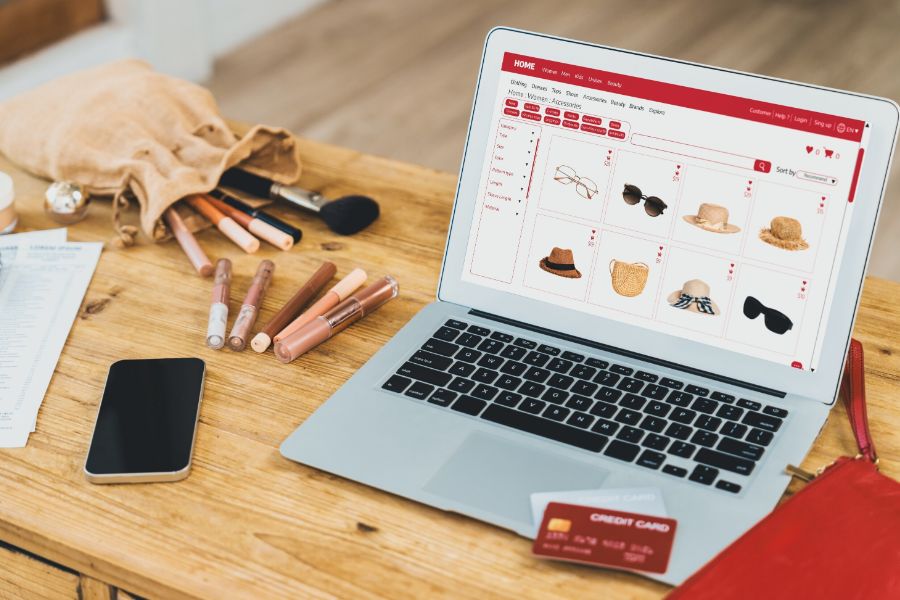As the COVID-19 pandemic accelerated the shift to online shopping, businesses worldwide have had to rethink their digital strategies. To meet this growing demand, Commercetools, a German tech innovator, has introduced a cutting-edge e-commerce platform designed to help large businesses streamline operations, enhance customer experiences, and drive sales.
Built with a modern, API-first, headless commerce architecture, Commercetools empowers retailers to create flexible, scalable, and personalized online shopping experiences. In this article, we’ll explore the key features, benefits, and real-world impact of Commercetools, showcasing how it’s transforming the future of e-commerce.
What is Commercetools?
Commercetools is a cutting-edge, cloud-based headless commerce platform that empowers B2C (Business-to-Consumer) and B2B (Business-to-Business) enterprises of any size. Built on the modern MACH principles — microservice-based, API-first, Cloud-native, and Headless — it offers unparalleled flexibility, allowing businesses to tailor and expand their commerce solutions to meet specific requirements.
This platform delivers a robust array of commerce functionalities, including catalog management, a unified cart system, order management, machine learning capabilities, a merchant center, and extensive developer tooling. Its potent and well-documented APIs facilitate seamless integration with a variety of frontends and third-party applications, enabling businesses to create superior customer experiences across all digital channels.
Commercetools is trusted by over 250 organizations worldwide and has been recognized as a leader in digital commerce by industry analysts like Gartner and IDC.
ConnectPOS stands out for its direct integration capabilities with Commercetools at the intersection of integration solutions and operational optimization. Aligned with MACH principles, ConnectPOS is particularly well-suited for enterprises looking to enhance growth and efficiency using Commercetools. This synergy between ConnectPOS and Commercetools facilitates seamless operations, unlocking new levels of efficiency and scalability for businesses.
How Does Commercetools Work? A Deep Dive into Its Functionality
Commercetools is a cloud-based, API-first, and headless commerce platform designed to provide businesses with unmatched flexibility and scalability in managing their e-commerce operations. Unlike traditional monolithic e-commerce systems, Commercetools separates the front-end (customer-facing experience) from the back-end (commerce logic and data processing), allowing brands to create highly customized and seamless shopping experiences across multiple channels.
Key Components of Commercetools:
- Microservices-based architecture
Commercetools utilizes a Microservices-based architecture, dividing the eCommerce POS platform into smaller, independent components. Each microservice is responsible for a specific function and operates independently, enhancing the flexibility and scalability of the system. This architecture allows for independent development, deployment, and management of each component, leading to faster updates and more reliable performance.
- API-first design
In an API-first design, Application Programming Interfaces (APIs) are developed prior to the eCommerce system itself. Commercetools adopts this approach, ensuring that all system components are designed to work seamlessly together from the start. With over 300 APIs available, developers can build robust eCommerce systems that are flexible, scalable, and quick to market.
- Cloud-native platform
As a cloud-native platform, Commercetools fully leverages cloud capabilities such as flexibility, scalability, and security. Hosted on major cloud providers like Google Cloud and Amazon Web Services (AWS), it employs distributed applications and microservices to ensure high availability and performance across global data centers.
The headless architecture of Commercetools separates the user interface from the backend processes. This decoupling allows for greater flexibility in UI development and enhances the system’s scalability and performance. By focusing exclusively on backend processes, Commercetools provides powerful APIs that facilitate diverse and dynamic user interfaces across various digital touchpoints.
By implementing these advanced technological principles, Commercetools delivers a robust, scalable, and flexible eCommerce solution that meets the demands of modern digital commerce.
Why Do Retailers Choose Commercetools?
In today’s fast-evolving digital landscape, retailers need agile, scalable, and flexible e-commerce solutions to stay ahead of the competition. Commercetools has emerged as a preferred choice for retailers worldwide due to its headless commerce architecture, API-first approach, and microservices-based infrastructure—empowering brands to deliver seamless omnichannel experiences and innovate at speed.
Key Reasons Retailers Choose Commercetools:
- Personalization
Commercetools frees retailers from the constraints of monolithic systems, eliminating the need to adhere to a predetermined front-end structure or templating system. This independence allows retailers to uniquely shape their brand’s online presence uniquely, ensuring their website and app stand out in a competitive market.
Complementing this, ConnectPOS offers extensive customization options, enabling retailers to tailor solutions that meet specific industry needs and adapt to changing market conditions. This flexibility ensures seamless integration with Commercetools and supports effective scaling.
- Independence
Commercetools allows retailers to experiment on their commerce platforms without jeopardizing the entire ecosystem.
For example, retailers can test new features on specific parts of their websites without impacting backend operations. In contrast, traditional commerce solutions often require simultaneous front-end and back-end modifications, sometimes necessitating downtime for maintenance.
Additionally, ConnectPOS enhances customer independence by enabling in-store shoppers to use their mobile devices for a variety of actions, such as self-checkout, adding items to a wishlist, and making payments, thereby enhancing the shopping experience.
- Scalability
With its microservices architecture, Commercetools ensures that the front-end and back-end can be scaled independently. This means that even during periods of high traffic, the stability of the backend isn’t compromised.
ConnectPOS leverages this architecture to help enterprises expand internationally, offering features like language customization, diverse payment gateway integrations, and localized tax management, thereby facilitating global market penetration.
- Promptness
The decoupled structure of Commercetools accelerates UI development, allowing for rapid implementation and updates without the need for extensive backend testing. This not only saves time but also enhances the efficiency of the development process.
ConnectPOS complements this with a user-friendly UI that minimizes cashier errors and accelerates transactions, especially critical during peak shopping seasons. This system supports dynamic updates, such as modifying the customer-facing display, which enhances the customer experience and drives sales.
- Touchpoint addition
Headless commerce architecture enables the addition of new touchpoints without the need for additional backend maintenance. This architecture, supported by Commercetools, allows retailers to expand their digital footprint and explore new market opportunities easily.
The seamless integration with ConnectPOS ensures a consistent omnichannel experience, centralizes customer data for better decision-making, and supports scalable, personalized customer engagements across multiple platforms.
By leveraging these capabilities, Commercetools and ConnectPOS provide a robust framework for retailers aiming to enhance operational efficiency, personalize customer interactions, and expand their market reach, thereby driving success in a competitive retail environment.

Common Challenges When Using Commercetools
While Commercetools offers unparalleled flexibility and scalability for modern retailers, adopting this headless, API-first e-commerce platform comes with its own set of challenges. Businesses need to be aware of these potential hurdles to ensure a smooth implementation and efficient operation.
- Complexity of integration
Commercetools’ API-first, microservices-based architecture provides great flexibility and scalability, but integrating these services into an existing IT ecosystem can be complex. Organizations often require skilled developers familiar with API management and microservices architectures. This complexity can lead to longer initial setup times and could necessitate significant training or hiring of specialized personnel.
- Steep learning curve
The decoupled nature of headless commerce systems like Commercetools means that developers and content managers must adapt to a more segmented approach to managing front-end and back-end systems. This separation can be challenging for teams accustomed to more traditional, monolithic eCommerce platforms where the front-end and back-end are tightly integrated. The steep learning curve may slow down initial adoption and could temporarily reduce productivity as teams get up to speed.
- Cost considerations
While Commercetools can ultimately lead to cost savings through improved efficiency and scalability, the initial investment can be significant. Costs can accrue from the need for specialized development resources, potential integration challenges, and the subscription pricing model based on API usage. For smaller businesses or those with limited budgets, these costs can be a substantial barrier to entry.
- Dependency on external systems
Since Commercetools operates primarily as a back-end system, it relies heavily on external systems for the front-end and other functionalities. This dependency means that any disruptions in these external services can directly impact the performance and availability of the eCommerce platform. Additionally, managing multiple service providers and ensuring they all work harmoniously can add another layer of complexity and potential points of failure.
- Data security and compliance
Handling customer data across multiple services and APIs increases the complexity of ensuring data security and compliance with regulations such as GDPR or CCPA. Each integration point can potentially introduce vulnerabilities, requiring robust security protocols and continuous monitoring to protect sensitive information and maintain compliance.
Ideal Candidates for Commercetools
Commercetools is a powerful headless commerce platform designed for businesses that require flexibility, scalability, and seamless omnichannel integration. While it may not be the best fit for every retailer, certain businesses can maximize its potential to transform their e-commerce operations.
1. Large enterprises
Commercetools thrives in complex, large-scale environments where its ability to manage vast amounts of eCommerce transactions efficiently is a significant asset. Large enterprises often deal with multiple brands, diverse regional requirements, and complex product catalogs. The microservices architecture of Commercetools allows these companies to scale and customize their eCommerce solutions extensively, meeting global demands and localizing experiences without compromising on performance.
2. Businesses with a strong focus on omnichannel retail
Companies that engage in extensive omnichannel retailing—integrating physical stores, online shops, mobile apps, and other digital touchpoints—will find Commercetools especially beneficial. Its API-first approach enables seamless integration with various front-ends and third-party systems, facilitating a consistent and unified customer experience across all channels.
3. Technologically advanced organizations
Organizations that have already embraced digital transformation and possess in-house technical expertise will be well-positioned to leverage Commercetools. The platform’s headless commerce model offers greater flexibility and control over the user experience but requires a solid understanding of modern web development practices and architectures to exploit its capabilities fully.
4. Businesses with unique customization needs
Companies that require a high degree of customization in their eCommerce operations, such as unique workflow integrations, specialized product configurations, or specific customer engagement strategies, will find Commercetools highly accommodating. The platform’s design allows businesses to develop custom functionalities without being constrained by the limitations of standard eCommerce solutions.
Final thoughts
Commercetools stands as a pioneering solution in the eCommerce platform arena, characterized by its API-first design and microservices architecture. It excels in serving large enterprises and businesses focused on omnichannel strategies, offering unparalleled customization, scalability, and integration capabilities. This platform not only meets current operational needs but is also primed for the future of global digital commerce. By enabling companies to adapt quickly to new market trends and integrate emerging technologies smoothly, Commercetools positions organizations to succeed in a rapidly evolving digital environment. Its forward-thinking approach makes it an indispensable asset for businesses aiming to lead in innovation and customer engagement.
ConnectPOS seamlessly integrates with Commercetools and a variety of other robust platforms, ensuring a versatile and powerful point of sale solution for your business needs. Contact us today to explore how ConnectPOS can enhance your sales strategy and streamline operations.
ConnectPOS is a all-in-one point of sale solution tailored to meet your eCommerce POS needs, streamline business operations, boost sales, and enhance customer experience in diverse industries. We offer custom POS with features, pricing, and plans to suit your unique business requirements.




